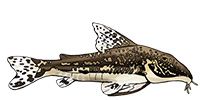We've kept Bunocephalus oracoideus off and on for a while and always thought of "banjos" as shy and sedentary fish. Lately we've been keeping some Bunocephalus verrucosus in a 55 gal planted S. American tank, and have beeen surprised by just how active these fish are. Not only do they swim, they regularly cruise across the tank, especially when I feed FD or frozen food.
Which other banjo species are similarly active?
Dinyar
Flying banjos
- Dinyar
- Posts: 1286
- Joined: 31 Dec 2002, 00:34
- My articles: 3
- My images: 226
- My catfish: 10
- My cats species list: 3 (i:10, k:0)
- Spotted: 94
- Location 1: New York, NY, USA
- Interests: Mochokidae, Claroteidae, Bagridae, Malepteruridae, Chacidae, Heteropneustidae, Clariidae, Sisoridae, Loricariiadae
- Silurus
- Posts: 12479
- Joined: 31 Dec 2002, 11:35
- I've donated: $12.00!
- My articles: 55
- My images: 903
- My catfish: 1
- My cats species list: 90 (i:1, k:0)
- Spotted: 433
- Location 1: Singapore
- Location 2: Moderator Emeritus
I have a <i>B. verrucosus</i>, and it's only a little tad more active than the <i>B. coracoideus</i> and the <i>Dysichthys quadriradiatus</i> it shares the tank with. Although it is the only banjo cat that would actually move during feeding time, I still don't see it come out as often as I would like.
There are even more sedentary cats, though. One <i>Acrochordonichthys</i> (Asian banjo) that I kept stayed at the exact same spot in the tank for two weeks and would feed by merely opening its mouth and gulping bloodworms that I sprayed from a dropper right in front of it.
There are even more sedentary cats, though. One <i>Acrochordonichthys</i> (Asian banjo) that I kept stayed at the exact same spot in the tank for two weeks and would feed by merely opening its mouth and gulping bloodworms that I sprayed from a dropper right in front of it.

- Dinyar
- Posts: 1286
- Joined: 31 Dec 2002, 00:34
- My articles: 3
- My images: 226
- My catfish: 10
- My cats species list: 3 (i:10, k:0)
- Spotted: 94
- Location 1: New York, NY, USA
- Interests: Mochokidae, Claroteidae, Bagridae, Malepteruridae, Chacidae, Heteropneustidae, Clariidae, Sisoridae, Loricariiadae
Never heard of Dysichthys quadriradiatus before, and notice there isn't a pic in the Catelog. (Why don't you contribute one...? hint, hint) What does it look like?
Anyone keep Xyliphius spp? The pix look interesting, but I've never seen one live or even on anyone's sales list.
Dinyar
Anyone keep Xyliphius spp? The pix look interesting, but I've never seen one live or even on anyone's sales list.
Dinyar
Last edited by Dinyar on 29 Jan 2003, 15:05, edited 1 time in total.
- Silurus
- Posts: 12479
- Joined: 31 Dec 2002, 11:35
- I've donated: $12.00!
- My articles: 55
- My images: 903
- My catfish: 1
- My cats species list: 90 (i:1, k:0)
- Spotted: 433
- Location 1: Singapore
- Location 2: Moderator Emeritus
Actually, it may have been <i>D. depressus</i>. Not too sure about the id. Looks like a regular banjo (<i>B. coracoideus</i>), except that the body (but not the caudal peduncle) is much shorter and more slender, the eyes are closer together and the coloration is much lighter (a rich medium brown). Found it for sale as a regular banjo in one of those chain pet stores.
Will get around to posting pics of it, when I scrape up enough money to buy a digital camera.
As for <i>Xyliphius</i>, why not ask Shane ? They are found in the Rio Magdalena, which is where the three of us (Jools, Shane and me ) will be fishing before or after ASIH Manaus.
Will get around to posting pics of it, when I scrape up enough money to buy a digital camera.
As for <i>Xyliphius</i>, why not ask Shane ? They are found in the Rio Magdalena, which is where the three of us (Jools, Shane and me ) will be fishing before or after ASIH Manaus.





